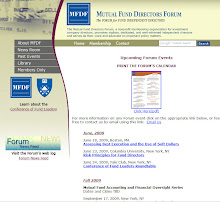In a recently released document, "US Mutual Funds: Unprecedented Challenges, Compelling Opportunities," Ernst & Young LLP took a look at the current state of the mutual fund industry, and makes some predictions about where the industry may be headed. The fund industry, though resilient, faces unprecedented challenges:
become much more concentrated among the larger players in the coming years, and larger firms are likely to maintain money market offerings for two key reasons:
E&Y also predicts that funds will reevaluate their offerings bearing in mind the strategic value of each fund or product, and rationalizing the range of products they offer by consolidating similar products, and liquidating those not expected to rebound as the economy recovers. E&Y anticipates growth in the retirement market, particularly among target-date funds and exchange traded funds. Though target-date funds performed poorly in the recent downturn, and are subject to intense scrutiny by the SEC and DOL, E&Y expects the target-date fund to survive and, indeed, flourish as managers reassess the modeling assumptions used in target-date fund glide paths.
Given the federal government's support for distressed credit markets, E&Y also predicts that credit-focused funds will also be lucrative and popular. Given restrictions on mutual fund leverage, mutual funds may find themselves competing with hedge funds in the credit-focused space; but innovative advisers may be able to create cross-over "hedge fund style" mutual funds to participate in the credit-focused market. E&Y cautions:
The full text of E&Y's "US Mutual Funds: Unprecedented Challenges, Compelling Opportunities" is available at: https://eyaprimo.ey.com/natlmktgaprimoey/etrack.aspx?DSN=NationalMarketing&FORMID=57115&INTID=60934&AUDID=714597&URL=https://eyaprimo.ey.com/natlmktgaprimoey/Attachments/AssetMgmt_J00352.pdf
Clearly, these are unprecedented times for the US mutual fund industry. What marks the present crisis as unique from earlier ones is the sheer range and magnitude of the challenges confronting all mutual fund sponsors — from the smallest regional shops right up to the top-tier global asset managers with the farthest-reaching fund complexes. The most direct impact of the financial crisis and the ensuing global economic slowdown has been on the investment performance among mutual funds in a variety of asset classes, sectors and strategies. Although absolute performance has picked up since early March 2009, equity funds have a long way to go before they recoup the significant negative returns they experienced in 2008 and early 2009 as stock markets tumbled.With these challenges in mind, Ernst & Young envisions that this period presents some unique opportunities for the industry to reform and evolve.
So with performance track records in many instances tarnished, fee revenues in decline and dramatic shifts in investor risk appetite and the competitive landscape, the US mutual fund industry stands at a crossroads. In some cases, the challenges have been caused by the financial crisis, while in others, the turmoil has merely hastened the nee to tackle preexisting challenges and issues head-on.The document makes some predictions about the future of the industry as well. The firm predicts that money market mutual fund assets will
become much more concentrated among the larger players in the coming years, and larger firms are likely to maintain money market offerings for two key reasons:
- With a larger, more diversified fund complex, advisers are reasoning that they can ride out the current low-yield environment until stronger profitability returns.
- Investor risk aversion can only last so long. Making new sales is difficult and costly; money market funds are viewed as a future gateway for directing client money into equity and fixed-income mutual funds.
E&Y also predicts that funds will reevaluate their offerings bearing in mind the strategic value of each fund or product, and rationalizing the range of products they offer by consolidating similar products, and liquidating those not expected to rebound as the economy recovers. E&Y anticipates growth in the retirement market, particularly among target-date funds and exchange traded funds. Though target-date funds performed poorly in the recent downturn, and are subject to intense scrutiny by the SEC and DOL, E&Y expects the target-date fund to survive and, indeed, flourish as managers reassess the modeling assumptions used in target-date fund glide paths.
Given the federal government's support for distressed credit markets, E&Y also predicts that credit-focused funds will also be lucrative and popular. Given restrictions on mutual fund leverage, mutual funds may find themselves competing with hedge funds in the credit-focused space; but innovative advisers may be able to create cross-over "hedge fund style" mutual funds to participate in the credit-focused market. E&Y cautions:
Executives moving into this space need to carefully examine how they structure these funds from a regulatory perspective. They must consider mutual fund requirements on such factors as liquidity, leverage, redemption risk, valuation and the use of cash.Given the new market landscape and mood of mutual fund investors, E&Y predicts mutual funds will return to a "back to basics" approach overall.
The current market conditions have given fund companies the platform to re-evaluate and rationalize their products, people and operations. After years of high growth and a proliferation of new products with less focus on costs and risk management, investment managers have been forced to “go back to their core business.”This means less reliance on exotic and complex securities, and adoption of complex-wide risk management approaches addressing market, credit, operational, and liquidity risks.
The full text of E&Y's "US Mutual Funds: Unprecedented Challenges, Compelling Opportunities" is available at: https://eyaprimo.ey.com/natlmktgaprimoey/etrack.aspx?DSN=NationalMarketing&FORMID=57115&INTID=60934&AUDID=714597&URL=https://eyaprimo.ey.com/natlmktgaprimoey/Attachments/AssetMgmt_J00352.pdf





